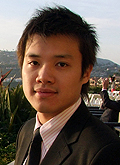 |
Leo Boneschansker, M.D.Email: This email address is being protected from spambots. You need JavaScript enabled to view it. |
 |
Felix Ellett, Ph.D.Felix's current research is focused on development of simple microfluidic devices to assay leukocyte functions, including migration and host-pathogen interactions. These assays can then be used to better understand both the biology of healthy neutrophils and the mechanisms that underpin disfunction in diseases such as sepsis. Email: This email address is being protected from spambots. You need JavaScript enabled to view it. |
 |
Mehdi Jorfi, Ph.D.University of Fribourg, 2014 Email: This email address is being protected from spambots. You need JavaScript enabled to view it. |
 |
Joao Paulo Oliveira Da Costa, Ph.D.Email: This email address is being protected from spambots. You need JavaScript enabled to view it. |
 |
Avanish Mishra, Ph.D.Purdue University, 2016 Email: This email address is being protected from spambots. You need JavaScript enabled to view it. |
 |
Baris Mutlu, Ph.D.University of Minnesota, 2016 Email: This email address is being protected from spambots. You need JavaScript enabled to view it. |
 |
Murat Karabacak, Ph.D.Dr. Karabacak's current research interest is developing lossless methods for analysis of circulating tumor cells. Microfluidic platforms are used for immuno-magnetic depletion of normal (negative) cells from the blood of metastatic cancer patients. Isolated cells are immobilized on glass surfaces for staining and high resolution imaging. Email: This email address is being protected from spambots. You need JavaScript enabled to view it. |
 |
Rebecca Sandlin, Ph.D.Dr. Sandlin is working to develop new biopreservation techniques. Specifically, she is interested in developing methods for preserving rare cell types under ambient conditions. Email: This email address is being protected from spambots. You need JavaScript enabled to view it. |
 |
Shannon Tessier, Ph.D.Carlton University, 2014 My primary research is to develop novel methods for the limitation of organ injury for the purpose of transplantation and strategies for the stabilization of peripheral blood and its components which are compatible with microfluidic processing and molecular diagnostics. A common theme across these projects is the control of biological time and promoting the broad dissemination of life-saving technology. Email: This email address is being protected from spambots. You need JavaScript enabled to view it. |
 |
Lindong Weng, Ph.D.Dalian University of Technology, 2012 Dr. Weng's research interests concentrate around the understanding of the biophysical phenomena occurring in cryopreservation, including thermodynamics of phase changes, mass transfer, and material characterization. He is mainly working on developing biopreservation methods for biologics of urgent necessity for the research communities. Email: This email address is being protected from spambots. You need JavaScript enabled to view it. |
 |
Xiao Wang, Ph.D.University of Cincinnati, 2016 Email: This email address is being protected from spambots. You need JavaScript enabled to view it. |
 |
Keith Wong, Ph.D.Biomedical Engineering, Boston University, 2012 Dr. Wong is working on preservation strategies to stabilize whole blood ex vivo for microfluidic diagnostics. Email: This email address is being protected from spambots. You need JavaScript enabled to view it. |
 |
Alex Hopke, Ph.D.University of Maine, 2016 Email: This email address is being protected from spambots. You need JavaScript enabled to view it. |
 |
Jenny Nesbitt, Ph.D.Vanderbilt University, 2012 Email: This email address is being protected from spambots. You need JavaScript enabled to view it. |
|
Onur Tasci, Ph.D.
|
|
|
Daniel Rabe, Ph.D. |
|
|
Sinan Muldur, Ph.D. |
|
|
Derin Sevenler, Ph.D. |
 |
Shyam S. Bale, Ph.D.Rensselaer Polytechnic Institute, 2010Dr. Bale's primary research is to develop microfluidic platforms for real-time detection biomolecules in cellular secretions; and other metabolites. This technology will be combined with the living cell array to simultaneously monitor gene expression and protein secretion. This can be extended to identify biomolecules/proteins in small volumes in low concentrations with high sensitivity. Email:This email address is being protected from spambots. You need JavaScript enabled to view it. |
 |
Abhinav Bhushan, Ph.D.Louisiana State University, 2006 Email:This email address is being protected from spambots. You need JavaScript enabled to view it. |
|
|
|
|
|